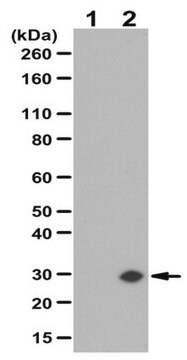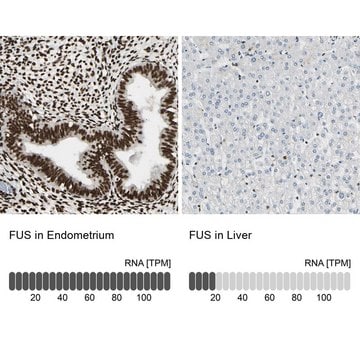MABN1616
Anti-GADD153/DDIT3/CHOP Antibody, clone 5E5.3
clone 5E5.3, from mouse
Synonim(y):
DNA damage-inducible transcript 3 protein, CCAAT/enhancer-binding protein homologous protein, C/EBP-homologous protein 10, C/EBP zeta, CHOP, CHOP-10, DDIT-3, Growth arrest and DNA damage-inducible protein GADD153
About This Item
Polecane produkty
pochodzenie biologiczne
mouse
Poziom jakości
forma przeciwciała
purified immunoglobulin
rodzaj przeciwciała
primary antibodies
klon
5E5.3, monoclonal
reaktywność gatunkowa
human
metody
immunocytochemistry: suitable
immunohistochemistry: suitable (paraffin)
western blot: suitable
izotyp
IgG1κ
numer dostępu NCBI
numer dostępu UniProt
docelowa modyfikacja potranslacyjna
unmodified
informacje o genach
human ... CEBPZ(10153)
Opis ogólny
Specyficzność
Immunogen
Zastosowanie
Immunohistochemistry Analysis: A 1:50 dilution from a representative lot detected GADD153/DDIT3 in human brain, kidney, and skeletal muscle tissue sections.
Neuroscience
Apoptosis - Additional
Jakość
Western Blotting Analysis: 1.0 µg/mL of this antibody detected GADD153/DDIT3 in 10 µg of HUVEC lysate.
Opis wartości docelowych
Postać fizyczna
Przechowywanie i stabilność
Inne uwagi
Oświadczenie o zrzeczeniu się odpowiedzialności
Not finding the right product?
Try our Narzędzie selektora produktów.
Kod klasy składowania
12 - Non Combustible Liquids
Klasa zagrożenia wodnego (WGK)
WGK 1
Temperatura zapłonu (°F)
Not applicable
Temperatura zapłonu (°C)
Not applicable
Certyfikaty analizy (CoA)
Poszukaj Certyfikaty analizy (CoA), wpisując numer partii/serii produktów. Numery serii i partii można znaleźć na etykiecie produktu po słowach „seria” lub „partia”.
Masz już ten produkt?
Dokumenty związane z niedawno zakupionymi produktami zostały zamieszczone w Bibliotece dokumentów.
Nasz zespół naukowców ma doświadczenie we wszystkich obszarach badań, w tym w naukach przyrodniczych, materiałoznawstwie, syntezie chemicznej, chromatografii, analityce i wielu innych dziedzinach.
Skontaktuj się z zespołem ds. pomocy technicznej







